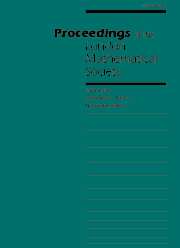Extremal mappings of finite distortion
Published online by Cambridge University Press: 19 October 2005
Abstract
The theory of mappings of finite distortion has arisen out of a need to extend the ideas and applications of the classical theory of quasiconformal mappings to the degenerate elliptic setting where one finds concrete applications in non-linear elasticity and the calculus of variations.
In this paper we initiate the study of extremal problems for mappings with finite distortion and extend the theory of extremal quasiconformal mappings by considering integral averages of the distortion function instead of its supremum norm. For instance, we show the following. Suppose that $f_o$ is a homeomorphism of the circle with $f_{o}^{-1} \in {\cal W}^{1/2, 2}$. Then there is a unique extremal extension to the disk which is a real analytic diffeomorphism with non-vanishing Jacobian determinant. The condition on $f_o$ is sharp.
Classically the mapping $f_o$ is assumed to be quasisymmetric. Then there is an extremal quasiconformal mapping with boundary values $f_o$, but it is not always unique and it is seldom smooth. Indeed, even when $f_o$ is quasisymmetric, the ${\cal L}^1$-minimiser for the distortion function will almost never be quasiconformal.
We further find that there are many new and unexpected phenomena concerning existence, uniqueness and regularity for these extremal problems where the functionals are polyconvex but typically not convex. These seem to differ markedly from phenomena observed when studying multi-well type functionals.
- Type
- Research Article
- Information
- Proceedings of the London Mathematical Society , Volume 91 , Issue 3 , November 2005 , pp. 655 - 702
- Copyright
- 2005 London Mathematical Society
Footnotes
- 72
- Cited by


